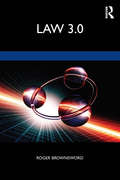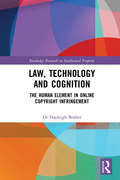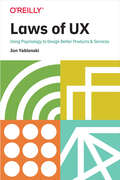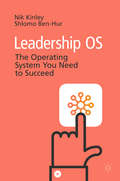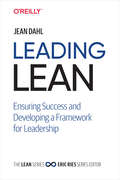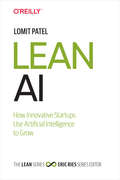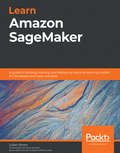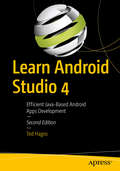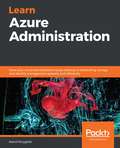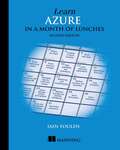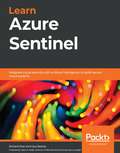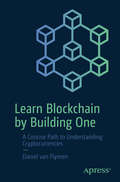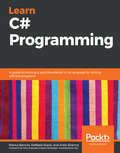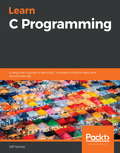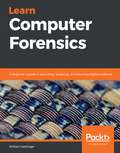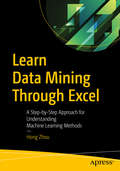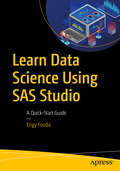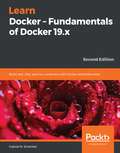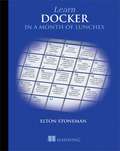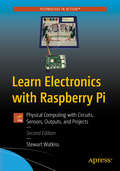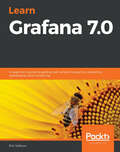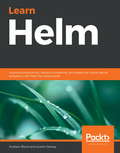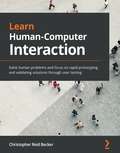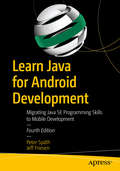- Table View
- List View
Law 3.0: Rules, Regulation, and Technology
by Roger BrownswordPutting technology front and centre in our thinking about law, this book introduces Law 3.0: the future of the legal landscape. Technology not only disrupts the traditional idea of what it is ‘to think like a lawyer,’ as per Law 1.0; it presents major challenges to regulators who are reasoning in a Law 2.0 mode. As this book demonstrates, the latest developments in technology offer regulators the possibility of employing a technical fix rather than just relying on rules – thus, we are introducing Law 3.0. Law 3.0 represents, so to speak, the state we are in and the conversation that we now need to have, and this book identifies some of the key points for discussion in that conversation. Thinking like a lawyer might continue to be associated with Law 1.0, but from 2020 onward, Law 3.0 is the conversation that we all need to join. And, as this book argues, law and the evolution of legal reasoning cannot be adequately understood unless we grasp the significance of technology in shaping both legal doctrine and our regulatory thinking. This is a book for those studying, or about to study, law – as well as others with interests in the legal, political, and social impact of technology.
Law, Technology and Cognition: The Human Element in Online Copyright Infringement (Routledge Research in Intellectual Property)
by Hayleigh BosherThis book considers a new approach to online copyright infringement. Rather than looking at the subject within a purely technological context, it provides legal analysis from a human perspective. This book highlights that there are three key instances in which the capacity of a human mind intersects with the development of copyright regulation: (1) the development of copyright statutory law; (2) the interpretation of the copyright statutory law the judiciary; and (3) human interaction with new technology. Using a novel framework for constructing digital perspectives, the author, Dr Hayleigh Bosher, analyses the laws relating to online copyright infringement. She provides insights into why the law appears as it does, shedding light on the circumstances of how it came to pass and demonstrates a clear malfunction in the interpretation and application of copyright law to online activities that derives from the disconnect between the technological and the human perspectives. The book proposes putting the human element back into copyright analysis to enable the return of reason where it has been lost, and provide a clearer, more consistent and fair legal regulation of online copyright infringement. Law, Technology and Cognition: The Human Element in Online Copyright Infringement will be of interest to students, academics, researchers, as well as practitioners.
Laws of UX: Using Psychology to Design Better Products & Services
by Jon YablonskiAn understanding of psychology—specifically the psychology behind how users behave and interact with digital interfaces—is perhaps the single most valuable nondesign skill a designer can have. The most elegant design can fail if it forces users to conform to the design rather than working within the “blueprint” of how humans perceive and process the world around them. This practical guide explains how you can apply key principles in psychology to build products and experiences that are more intuitive and human-centered. Author Jon Yablonski deconstructs familiar apps and experiences to provide clear examples of how UX designers can build experiences that adapt to how users perceive and process digital interfaces.You’ll learn:How aesthetically pleasing design creates positive responsesThe principles from psychology most useful for designersHow these psychology principles relate to UX heuristicsPredictive models including Fitts’s law, Jakob’s law, and Hick’s lawEthical implications of using psychology in designA framework for applying these principles
Le Kindle Fire HD 8 & 10 Guide 2019 Mise À Jour: Moyens faciles et rapides pour comprendre votre Kindle Fire HD et solution aux problèmes courants
by Smith AnthonyTHE KINDLE FIRE HD 8 & 10 GUIDE 2019 MISE À JOUR Les guides de ce manuel sont principalement destinés aux utilisateurs de KINDLE Fire qui n'ont rien appris de nouveau sur la façon de maximiser votre Kindle Fire HD 8 et 10. Vous obtiendrez de nouveaux trucs et astuces cachés qui vous permettront de maîtriser votre appareil. Ce manuel vous guidera pas à pas vers les fonctions avancées des processus Kindle Fire HD 8 et 10 sur la configuration initiale, les fonctions de base, les paramètres avancés et bien plus encore. D'autres informations importantes que vous obtiendrez de ce livre incluent ; Raison du Kindle Fire HD 8 et 10 Comment mettre en place Kindle feu HD 8 et 10 La meilleure façon de charger votre Kindle Fire HD 8 et 10 À L'AIDE D'UN ORDINATEUR À L'AIDE D'UN ADAPTATEUR MURAL Navigation sur l'écran de votre terminal Magasiner sur Amazon Fonctionnalité des trois boutons de l'écran de votre appareil Magasiner sur Amazon COMMENT FAIRE UN MIROIR DE VOTRE FEU ALLUMÉ HD À VOTRE TÉLÉVISEUR À L'AIDE D'UN BÂTON DE FEU Comment accélérer votre feu lent HD Mon feu allumé ne s'allume pas. Votre feu allumé HD ne se charge pas Mon feu allumé n'a pas de son Comment maximiser Alexa sur un feu HD Comprimé Possibilité de pouvoir changer la couleur du clavier Possibilité de changer le texte à la voix de la parole Arrêt automatique pour le Wi-Fi Possibilité d'avoir des émojis ou des émoticônes sur le clavier Possibilité de changer le comportement d'autocorrection Comment retrouver votre tablette perdue à l'aide du GPS Fonds d'écran Capacité de refléter votre feu de Kindle Ne tergiversez pas davantage, naviguez vers le haut et cliquez sur le bouton "ACHETER" pour obtenir ce manuel afin de maîtriser votre appareil et devenir un expert en K
Leadership OS: The Operating System You Need to Succeed
by Nik Kinley Shlomo Ben-HurBased on years of original research, this book controversially counters almost every existing leadership model and approach.It shows how as leaders rise to senior levels, their roles become less about doing things that directly drive results and more about directing and supporting others to achieve objectives. Using case studies and research insights the authors reveal how leadership success is thus not so much about having the right core capabilities, but about creating the right environment.Using the analogy of a smartphone operating system (OS), the book presents a new way of thinking about leadership. The authors provide a clear and practical framework to follow and show how your leadership OS becomes the impact you have, the imprint you make and the foundation of your legacy as a leader.After reading it, you will learn:· How to diagnose the impact you have as a leader and understand the OS you create· How famous business and societal leaders have created effective – and sometimes ineffective – OSs· How to optimise your OS to produce the best results· How to get people working together effectively, and be a high-performing leaderProviding you with practical and easy to follow advice, this book will show you how leadership success is not about having the core capabilities, but about creating the right operating systems for your organisation.
Leading Lean: Ensuring Success and Developing a Framework for Leadership
by Jean DahlCompanies from startups to corporate giants face massive amounts of disruption today. Now more than ever, organizations need nimble and responsive leaders who know how to exploit the opportunities that change brings. In this insightful book, Jean Dahl, a senior executive and expert in the Lean mindset and its methods, demonstrates why you need to embrace Modern Lean principles and thinking to redefine leadership in this age of digital disruption in order to continuously evolve the Lean enterprise.Drawing on nearly three decades of corporate and consulting experience, Ms. Dahl lays out a new holistic framework for developing Modern Lean leaders. Through personal experiences and compelling real-world case studies, she explains specific steps necessary for you and your company to proactively understand and respond to change. <li>Understand the leadership challenges <li>Lean leaders face in our 21st century global economy <li>Explore the six dimensions of the Modern Lean Framework™ <li>Learn and apply the nine steps necessary to become a Lean leader <li>Use Modern Lean methods to build a culture of continuous learning that can be sustained and maintained within your organization <li>Seize competitive advantage by embracing Modern Lean to tbuild an enterprise that understands how to respond to disruption
Lean AI: How Innovative Startups Use Artificial Intelligence to Grow
by Lomit PatelHow can startups successfully scale customer acquisition and revenue growth with a Lean team? Out-of-the-box acquisition solutions from Facebook, Google, and others provide a good start, but the companies that can tailor those solutions to meet their specific needs, objectives, and goals will come out winners. But that hasn’t been an easy task—until now.With this practical book, author Lomit Patel shows you how to use AI and automation to provide an operational layer atop those acquisition solutions to deliver amazing results for your company. You’ll learn how to adapt, customize, and personalize cross-channel user journeys to help your company attract and retain customers—to usher in the new age of Autonomous Marketing.Learn how AI and automation can support the customer acquisition efforts of a Lean startupDive into Customer Acquisition 3.0, an initiative for gaining and retaining customersExplore ways to use AI for marketing purposesUnderstand the key metrics for determining the growth of your startupDetermine the right strategy to foster user acquisition in your companyManage the increased complexity and risk inherent in AI projects
Learn Amazon SageMaker: A guide to building, training, and deploying machine learning models for developers and data scientists
by Julien Simon Francesco PochettiQuickly build and deploy machine learning models without managing infrastructure, and improve productivity using Amazon SageMaker's capabilities such as Amazon SageMaker Studio, Autopilot, Experiments, Debugger, and Model Monitor Key Features Build, train, and deploy machine learning models quickly using Amazon SageMaker Analyze, detect, and receive alerts relating to various business problems using machine learning algorithms and techniques Improve productivity by training and fine-tuning machine learning models in production Book Description Amazon SageMaker enables you to quickly build, train, and deploy machine learning (ML) models at scale, without managing any infrastructure. It helps you focus on the ML problem at hand and deploy high-quality models by removing the heavy lifting typically involved in each step of the ML process. This book is a comprehensive guide for data scientists and ML developers who want to learn the ins and outs of Amazon SageMaker. You'll understand how to use various modules of SageMaker as a single toolset to solve the challenges faced in ML. As you progress, you'll cover features such as AutoML, built-in algorithms and frameworks, and the option for writing your own code and algorithms to build ML models. Later, the book will show you how to integrate Amazon SageMaker with popular deep learning libraries such as TensorFlow and PyTorch to increase the capabilities of existing models. You'll also learn to get the models to production faster with minimum effort and at a lower cost. Finally, you'll explore how to use Amazon SageMaker Debugger to analyze, detect, and highlight problems to understand the current model state and improve model accuracy. By the end of this Amazon book, you'll be able to use Amazon SageMaker on the full spectrum of ML workflows, from experimentation, training, and monitoring to scaling, deployment, and automation. What you will learn Create and automate end-to-end machine learning workflows on Amazon Web Services (AWS) Become well-versed with data annotation and preparation techniques Use AutoML features to build and train machine learning models with AutoPilot Create models using built-in algorithms and frameworks and your own code Train computer vision and NLP models using real-world examples Cover training techniques for scaling, model optimization, model debugging, and cost optimization Automate deployment tasks in a variety of configurations using SDK and several automation tools Who this book is for This book is for software engineers, machine learning developers, data scientists, and AWS users who are new to using Amazon SageMaker and want to build high-quality machine learning models without worrying about infrastructure. Knowledge of AWS basics is required to grasp the concepts covered in this book more effectively. Some understanding of machine learning concepts and the Python programming language will also be beneficial.
Learn Android Studio 4: Efficient Java-Based Android Apps Development
by Ted HagosBuild and deploy your Java-based Android apps using the popular and efficient Android Studio 4 suite of tools, an integrated development environment (IDE) for today's Android developers. With this book, you’ll learn the latest and most productive tools in the Android tools ecosystem, ensuring quick Android app development and minimal effort on your part. Among these tools, you'll use the new Android Studio 4 features, including an upgraded CPU profiler UI, a new build speed window, the multi-preview feature, and the live layout inspector. After reading and using this book, you'll be able to efficiently build complete Java-based Android apps that run on any Android smartphone, tablet, smart watch and more. You’ll also be able to publish those apps and sell them online and in the Google Play store. What You Will Learn Use Android Studio 4 to quickly and confidently build your first Android apps Build an Android user interface using activities and layouts, event handling, images, menus, and the action bar Work with new tools in Android Studio 4: Jetpack compose support, a smart editor for ProGuard rules, a new motion layout editor, a new Android Gradle plugin, and a fragment wizard with new fragment templates Integrate data with data persistence Access the cloud Who This Book Is For Those who may be new to Android Studio 4 or Android Studio in general. You may or may not be new to Android development. Some prior experience with Java is recommended.
Learn Azure Administration: Solve your cloud administration issues relating to networking, storage, and identity management speedily and efficiently
by Kamil MrzyglodEnhance your Azure administration and Azure DevOps skills and get up and running with networking, security, automation, and effective cost managementKey FeaturesExplore a variety of administration patterns used for different cloud architecturesDiscover best practices for administering various IT systems hosted in AzureAdminister, automate, and manage your Azure cloud environment effectivelyBook DescriptionMicrosoft Azure is one of the upcoming cloud platforms that provide cost-effective solutions and services to help businesses overcome complex infrastructure-related challenges. This book will help you scale your cloud administration skills with Microsoft Azure.Learn Azure Administration starts with an introduction to the management of Azure subscriptions, and then takes you through Azure resource management. Next, you'll configure and manage virtual networks and find out how to integrate them with a set of Azure services. You'll then handle the identity and security for users with the help of Azure Active Directory, and manage access from a single place using policies and defined roles. As you advance, you'll get to grips with receipts to manage a virtual machine. The next set of chapters will teach you how to solve advanced problems such as DDoS protection, load balancing, and networking for containers. You'll also learn how to set up file servers, along with managing and storing backups. Later, you'll review monitoring solutions and backup plans for a host of services. The last set of chapters will help you to integrate different services with Azure Event Grid, Azure Automation, and Azure Logic Apps, and teach you how to manage Azure DevOps.By the end of this Azure book, you'll be proficient enough to easily administer your Azure-based cloud environment.What you will learnExplore different Azure services and understand the correlation between themSecure and integrate different Azure componentsWork with a variety of identity and access management (IAM) modelsFind out how to set up monitoring and logging solutionsBuild a complete skill set of Azure administration activities with Azure DevOpsDiscover efficient scaling patterns for small and large workloadsWho this book is forThis book is for cloud administrators, system administrators, and IT professionals who want to scale up their skillset and enter the world of cloud computing. IT professionals and engineers who are already familiar with the basics of the Azure services and are looking for a step-by-step guide to solving the most common Azure problems will also find this book useful. Basic understanding of cloud concepts such as IaaS, PaaS, virtualization, networking, and common Azure services is required.
Learn Azure in a Month of Lunches
by Iain FouldsLearn Azure in a Month of Lunches, Second Edition, is a tutorial on writing, deploying, and running applications in Azure. In it, you&’ll work through 21 short lessons that give you real-world experience. Each lesson includes a hands-on lab so you can try out and lock in your new skills.Summary You can be incredibly productive with Azure without mastering every feature, function, and service. Learn Azure in a Month of Lunches, Second Edition gets you up and running quickly, teaching you the most important concepts and tasks in 21 practical bite-sized lessons. As you explore the examples, exercises, and labs, you'll pick up valuable skills immediately and take your first steps to Azure mastery! This fully revised new edition covers core changes to the Azure UI, new Azure features, Azure containers, and the upgraded Azure Kubernetes Service. Purchase of the print book includes a free eBook in PDF, Kindle, and ePub formats from Manning Publications. About the technology Microsoft Azure is vast and powerful, offering virtual servers, application templates, and prebuilt services for everything from data storage to AI. To navigate it all, you need a trustworthy guide. In this book, Microsoft engineer and Azure trainer Iain Foulds focuses on core skills for creating cloud-based applications. About the book Learn Azure in a Month of Lunches, Second Edition, is a tutorial on writing, deploying, and running applications in Azure. In it, you&’ll work through 21 short lessons that give you real-world experience. Each lesson includes a hands-on lab so you can try out and lock in your new skills. What's inside Understanding Azure beyond point-and-click Securing applications and data Automating your environment Azure services for machine learning, containers, and more About the reader This book is for readers who can write and deploy simple web or client/server applications. About the author Iain Foulds is an engineer and senior content developer with Microsoft. Table of Contents PART 1 - AZURE CORE SERVICES 1 Before you begin 2 Creating a virtual machine 3 Azure Web Apps 4 Introduction to Azure Storage 5 Azure Networking basics PART 2 - HIGH AVAILABILITY AND SCALE 6 Azure Resource Manager 7 High availability and redundancy 8 Load-balancing applications 9 Applications that scale 10 Global databases with Cosmos DB 11 Managing network traffic and routing 12 Monitoring and troubleshooting PART 3 - SECURE BY DEFAULT 13 Backup, recovery, and replication 14 Data encryption 15 Securing information with Azure Key Vault 16 Azure Security Center and updates PART 4 - THE COOL STUFF 17 Machine learning and artificial intelligence 18 Azure Automation 19 Azure containers 20 Azure and the Internet of Things 21 Serverless computing
Learn Azure Sentinel: Integrate Azure security with artificial intelligence to build secure cloud systems
by Richard Diver Gary Bushey Jason S. RaderUnderstand how to set up, configure, and use Azure Sentinel to provide security incident and event management services for your environment Key Features Secure your network, infrastructure, data, and applications on Microsoft Azure effectively Integrate artificial intelligence, threat analysis, and automation for optimal security solutions Investigate possible security breaches and gather forensic evidence to prevent modern cyber threats Book Description Azure Sentinel is a Security Information and Event Management (SIEM) tool developed by Microsoft to integrate cloud security and artificial intelligence (AI). Azure Sentinel not only helps clients identify security issues in their environment, but also uses automation to help resolve these issues. With this book, you'll implement Azure Sentinel and understand how it can help find security incidents in your environment with integrated artificial intelligence, threat analysis, and built-in and community-driven logic. This book starts with an introduction to Azure Sentinel and Log Analytics. You'll get to grips with data collection and management, before learning how to create effective Azure Sentinel queries to detect anomalous behaviors and patterns of activity. As you make progress, you'll understand how to develop solutions that automate the responses required to handle security incidents. Finally, you'll grasp the latest developments in security, discover techniques to enhance your cloud security architecture, and explore how you can contribute to the security community. By the end of this book, you'll have learned how to implement Azure Sentinel to fit your needs and be able to protect your environment from cyber threats and other security issues. What you will learn Understand how to design and build a security operations center Discover the key components of a cloud security architecture Manage and investigate Azure Sentinel incidents Use playbooks to automate incident responses Understand how to set up Azure Monitor Log Analytics and Azure Sentinel Ingest data into Azure Sentinel from the cloud and on-premises devices Perform threat hunting in Azure Sentinel Who this book is for This book is for solution architects and system administrators who are responsible for implementing new solutions in their infrastructure. Security analysts who need to monitor and provide immediate security solutions or threat hunters looking to learn how to use Azure Sentinel to investigate possible security breaches and gather forensic evidence will also benefit from this book. Prior experience with cloud security, particularly Azure, is necessary.
Learn Blockchain by Building One: A Concise Path to Understanding Cryptocurrencies
by Daniel van FlymenAs crytpocurrencies and their underlying data structure, blockchains, become further intertwined in our daily lives, a full understanding of them is essential to anyone who wants to keep up and remain informed of the future of finance. There is no better learning method than a hands-on one, and Learn Blockchain by Building One offers just that.Develop your own blockchain using Python with step-by-step instructions from author Daniel van Flyman, an expert in the field. You will come away with a confident working knowledge of popular cryptocurrencies such as Bitcoin and Ethereum and which foundations make them work. Through helpful exercises and real-world examples, you will understand the core concepts of peer-to-peer networking, Proof of Work, hashing, encryption, and digital signatures.Learn Blockchain by Building One gives you timely, real-world lessons in blockchain and cryptocurrencies that you will need as our modern society becomes increasingly digitally sophisticated. The lasting implications of such technology, such as the security of personal transactions and the role of government regulation, are not to be underestimated. Stay ahead of the curve and become a confident blockchain builder now!What You Will LearnDevelop a fully-fledged blockchain in PythonObtain a ground-up understanding of of Proof of WorkGrasp core cryptographic concepts, such as hashing, encryption, and digital signaturesUnderstand how gossip protocols and peer-to-peer networking works by implementing a TCP client-serverRealize the differences and trade-offs between popular blockchains such as Bitcoin and Ethereum Who This Book Is For This book is aimed at intermediate programmers in any area from finance to academia. Readers should be comfortable reading and writing basic Python.
Learn C# Programming: A guide to building a solid foundation in C# language for writing efficient programs
by Marius Bancila Raffaele Rialdi Ankit Sharma Dino EspositoGet started with C# and strengthen your knowledge of core programming concepts such as procedural, object-oriented, generic, functional, and asynchronous programming along with the latest features of C# 8 Key Features Learn the fundamentals of C# with the help of easy-to-follow examples and explanations Leverage the latest features of C# 8, including nullable reference types, pattern matching enhancements, and asynchronous streams Explore object-oriented programming, functional programming, and multithreading concepts Book Description The C# programming language is often developers' primary choice for creating a wide range of applications for desktop, cloud, and mobile. In nearly two decades of its existence, C# has evolved from a general-purpose, object-oriented language to a multi-paradigm language with impressive features. This book will take you through C# from the ground up in a step-by-step manner. You'll start with the building blocks of C#, which include basic data types, variables, strings, arrays, operators, control statements, and loops. Once comfortable with the basics, you'll then progress to learning object-oriented programming concepts such as classes and structures, objects, interfaces, and abstraction. Generics, functional programming, dynamic, and asynchronous programming are covered in detail. This book also takes you through regular expressions, reflection, memory management, pattern matching, exceptions, and many other advanced topics. As you advance, you'll explore the .NET Core 3 framework and learn how to use the dotnet command-line interface (CLI), consume NuGet packages, develop for Linux, and migrate apps built with .NET Framework. Finally, you'll understand how to run unit tests with the Microsoft unit testing frameworks available in Visual Studio. By the end of this book, you'll be well-versed with the essentials of the C# language and be ready to start creating apps with it. What you will learn Get to grips with all the new features of C# 8 Discover how to use attributes and reflection to build extendable applications Utilize LINQ to uniformly query various sources of data Use files and streams and serialize data to JSON and XML Write asynchronous code with the async-await pattern Employ .NET Core tools to create, compile, and publish your applications Create unit tests with Visual Studio and the Microsoft unit testing frameworks Who this book is for If you have little experience in coding or C# and want to learn the essentials of C# programming to develop powerful programming techniques, this book is for you. It will also help aspiring programmers to write scripts or programs to accomplish specific tasks.
Learn C Programming: A beginner's guide to learning C programming the easy and disciplined way
by Jeff SzuhayGet started with writing simple programs in C while learning the skills that will help you work with practically any programming language Key Features Learn essential C concepts such as variables, data structures, functions, loops, and pointers Get to grips with the core programming aspects that form the base of many modern programming languages Explore the expressiveness and versatility of the C language with the help of sample programs Book Description C is a powerful general-purpose programming language that is excellent for beginners to learn. This book will introduce you to computer programming and software development using C. If you're an experienced developer, this book will help you to become familiar with the C programming language. This C programming book takes you through basic programming concepts and shows you how to implement them in C. Throughout the book, you'll create and run programs that make use of one or more C concepts, such as program structure with functions, data types, and conditional statements. You'll also see how to use looping and iteration, arrays, pointers, and strings. As you make progress, you'll cover code documentation, testing and validation methods, basic input/output, and how to write complete programs in C. By the end of the book, you'll have developed basic programming skills in C, that you can apply to other programming languages and will develop a solid foundation for you to advance as a programmer. What you will learn Understand fundamental programming concepts and implement them in C Write working programs with an emphasis on code indentation and readability Break existing programs intentionally and learn how to debug code Adopt good coding practices and develop a clean coding style Explore general programming concepts that are applicable to more advanced projects Discover how you can use building blocks to make more complex and interesting programs Use C Standard Library functions and understand why doing this is desirable Who this book is for This book is written for two very diverse audiences. If you're an absolute beginner who only has basic familiarity with operating a computer, this book will help you learn the most fundamental concepts and practices you need to know to become a successful C programmer. If you're an experienced programmer, you'll find the full range of C syntax as well as common C idioms. You can skim through the explanations and focus primarily on the source code provided.
Learn Computer Forensics: A beginner's guide to searching, analyzing, and securing digital evidence
by William OettingerGet up and running with collecting evidence using forensics best practices to present your findings in judicial or administrative proceedings Key Features Learn the core techniques of computer forensics to acquire and secure digital evidence skillfully Conduct a digital forensic examination and document the digital evidence collected Analyze security systems and overcome complex challenges with a variety of forensic investigations Book Description A computer forensics investigator must possess a variety of skills, including the ability to answer legal questions, gather and document evidence, and prepare for an investigation. This book will help you get up and running with using digital forensic tools and techniques to investigate cybercrimes successfully. Starting with an overview of forensics and all the open source and commercial tools needed to get the job done, you'll learn core forensic practices for searching databases and analyzing data over networks, personal devices, and web applications. You'll then learn how to acquire valuable information from different places, such as filesystems, e-mails, browser histories, and search queries, and capture data remotely. As you advance, this book will guide you through implementing forensic techniques on multiple platforms, such as Windows, Linux, and macOS, to demonstrate how to recover valuable information as evidence. Finally, you'll get to grips with presenting your findings efficiently in judicial or administrative proceedings. By the end of this book, you'll have developed a clear understanding of how to acquire, analyze, and present digital evidence like a proficient computer forensics investigator. What you will learn Understand investigative processes, the rules of evidence, and ethical guidelines Recognize and document different types of computer hardware Understand the boot process covering BIOS, UEFI, and the boot sequence Validate forensic hardware and software Discover the locations of common Windows artifacts Document your findings using technically correct terminology Who this book is for If you're an IT beginner, student, or an investigator in the public or private sector this book is for you.This book will also help professionals and investigators who are new to incident response and digital forensics and interested in making a career in the cybersecurity domain.
Learn Data Mining Through Excel: A Step-by-Step Approach for Understanding Machine Learning Methods
by Hong ZhouUse popular data mining techniques in Microsoft Excel to better understand machine learning methods.Software tools and programming language packages take data input and deliver data mining results directly, presenting no insight on working mechanics and creating a chasm between input and output. This is where Excel can help.Excel allows you to work with data in a transparent manner. When you open an Excel file, data is visible immediately and you can work with it directly. Intermediate results can be examined while you are conducting your mining task, offering a deeper understanding of how data is manipulated and results are obtained. These are critical aspects of the model construction process that are hidden in software tools and programming language packages.This book teaches you data mining through Excel. You will learn how Excel has an advantage in data mining when the data sets are not too large. It can give you a visual representation of data mining, building confidence in your results. You will go through every step manually, which offers not only an active learning experience, but teaches you how the mining process works and how to find the internal hidden patterns inside the data.What You Will LearnComprehend data mining using a visual step-by-step approachBuild on a theoretical introduction of a data mining method, followed by an Excel implementationUnveil the mystery behind machine learning algorithms, making a complex topic accessible to everyoneBecome skilled in creative uses of Excel formulas and functionsObtain hands-on experience with data mining and ExcelWho This Book Is ForAnyone who is interested in learning data mining or machine learning, especially data science visual learners and people skilled in Excel, who would like to explore data science topics and/or expand their Excel skills. A basic or beginner level understanding of Excel is recommended.
Learn Data Science Using SAS Studio: A Quick-Start Guide
by Engy FoudaDo you want to create data analysis reports without writing a line of code? This book introduces SAS Studio, a free data science web browser-based product for educational and non-commercial purposes. The power of SAS Studio comes from its visual point-and-click user interface that generates SAS code. It is easier to learn SAS Studio than to learn R and Python to accomplish data cleaning, statistics, and visualization tasks. The book includes a case study about analyzing the data required for predicting the results of presidential elections in the state of Maine for 2016 and 2020. In addition to the presidential elections, the book provides real-life examples including analyzing stocks, oil and gold prices, crime, marketing, and healthcare. You will see data science in action and how easy it is to perform complicated tasks and visualizations in SAS Studio.You will learn, step-by-step, how to do visualizations, including maps. In most cases, you will not need a line of code as you work with the SAS Studio graphical user interface. The book includes explanations of the code that SAS Studio generates automatically. You will learn how to edit this code to perform more complicated advanced tasks. The book introduces you to multiple SAS products such as SAS Viya, SAS Analytics, and SAS Visual Statistics. What You Will Learn Become familiar with SAS Studio IDEUnderstand essential visualizationsKnow the fundamental statistical analysis required in most data science and analytics reportsClean the most common data set problemsUse linear progression for data predictionWrite programs in SASGet introduced to SAS-Viya, which is more potent than SAS studio Who This Book Is For A general audience of people who are new to data science, students, and data analysts and scientists who are experienced but new to SAS. No programming or in-depth statistics knowledge is needed.
Learn Docker - Fundamentals of Docker 19.x: Build, test, ship, and run containers with Docker and Kubernetes, 2nd Edition
by Gabriel N. SchenkerExplore the core functionality of containerizing your applications and making them production-ready Key Features Grasp basic to advanced Docker concepts with this comprehensive guide Get acquainted with Docker containers, Docker images, orchestrators, cloud integration, and networking Learn to simplify dependencies and deploy and test containers in production Book Description Containers enable you to package an application with all the components it needs, such as libraries and other dependencies, and ship it as one package. Docker containers have revolutionized the software supply chain in both small and large enterprises. Starting with an introduction to Docker fundamentals and setting up an environment to work with it, you'll delve into concepts such as Docker containers, Docker images, and Docker Compose. As you progress, the book will help you explore deployment, orchestration, networking, and security. Finally, you'll get to grips with Docker functionalities on public clouds such as Amazon Web Services (AWS), Azure, and Google Cloud Platform (GCP), and learn about Docker Enterprise Edition features. Additionally, you'll also discover the benefits of increased security with the use of containers. By the end of this Docker book, you'll be able to build, ship, and run a containerized, highly distributed application on Docker Swarm or Kubernetes, running on-premises or in the cloud. What you will learn Containerize your traditional or microservice-based applications Develop, modify, debug, and test an application running inside a container Share or ship your application as an immutable container image Build a Docker Swarm and a Kubernetes cluster in the cloud Run a highly distributed application using Docker Swarm or Kubernetes Update or rollback a distributed application with zero downtime Secure your applications with encapsulation, networks, and secrets Troubleshoot a containerized, highly distributed application in the cloud Who this book is for This book is for system administrators, operations engineers, DevOps engineers, and developers or stakeholders who are interested in getting started with Docker from scratch. No prior experience with Docker containers is required.
Learn Docker in a Month of Lunches
by Elton StonemanSummary Go from zero to production readiness with Docker in 22 bite-sized lessons! Learn Docker in a Month of Lunches is an accessible task-focused guide to Docker on Linux, Windows, or Mac systems. In it, you&’ll learn practical Docker skills to help you tackle the challenges of modern IT, from cloud migration and microservices to handling legacy systems. There&’s no excessive theory or niche-use cases—just a quick-and-easy guide to the essentials of Docker you&’ll use every day. Purchase of the print book includes a free eBook in PDF, Kindle, and ePub formats from Manning Publications. About the technology The idea behind Docker is simple: package applications in lightweight virtual containers that can be easily installed. The results of this simple idea are huge! Docker makes it possible to manage applications without creating custom infrastructures. Free, open source, and battle-tested, Docker has quickly become must-know technology for developers and administrators. About the book Learn Docker in a Month of Lunches introduces Docker concepts through a series of brief hands-on lessons. Following a learning path perfected by author Elton Stoneman, you&’ll run containers by chapter 2 and package applications by chapter 3. Each lesson teaches a practical skill you can practice on Windows, macOS, and Linux systems. By the end of the month you&’ll know how to containerize and run any kind of application with Docker. What's inside Package applications to run in containers Put containers into production Build optimized Docker images Run containerized apps at scale About the reader For IT professionals. No previous Docker experience required. About the author Elton Stoneman is a consultant, a former architect at Docker, a Microsoft MVP, and a Pluralsight author. Table of Contents PART 1 - UNDERSTANDING DOCKER CONTAINERS AND IMAGES 1. Before you begin 2. Understanding Docker and running Hello World 3. Building your own Docker images 4. Packaging applications from source code into Docker Images 5. Sharing images with Docker Hub and other registries 6. Using Docker volumes for persistent storage PART 2 - RUNNING DISTRIBUTED APPLICATIONS IN CONTAINERS 7. Running multi-container apps with Docker Compose 8. Supporting reliability with health checks and dependency checks 9. Adding observability with containerized monitoring 10. Running multiple environments with Docker Compose 11. Building and testing applications with Docker and Docker Compose PART 3 - RUNNING AT SCALE WITH A CONTAINER ORCHESTRATOR 12. Understanding orchestration: Docker Swarm and Kubernetes 13. Deploying distributed applications as stacks in Docker Swarm 14. Automating releases with upgrades and rollbacks 15. Configuring Docker for secure remote access and CI/CD 16. Building Docker images that run anywhere: Linux, Windows, Intel, and Arm PART 4 - GETTING YOUR CONTAINERS READY FOR PRODUCTION 17. Optimizing your Docker images for size, speed, and security 18. Application configuration management in containers 19. Writing and managing application logs with Docker 20. Controlling HTTP traffic to containers with a reverse proxy 21. Asynchronous communication with a message queue 22. Never the end
Learn Electronics with Raspberry Pi: Physical Computing with Circuits, Sensors, Outputs, and Projects
by Stewart WatkissUpdated for the recent Raspberry Pi boards, including the Raspberry Pi 4, this new edition offers an all new digital logic circuits project, explaining the theory behind how digital electronics work while creating a new project for measuring temperature.Raspberry Pi is everywhere, it’s inexpensive, and it's a wonderful tool for teaching about electronics and programming. This book demonstrates how to make a variety of cool projects using the Pi with programming languages like Scratch and Python, with no experience necessary. You'll see how the Pi works, how to work with Raspbian Linux on the Pi, and how to design and create electronic circuits. You'll create projects like an arcade game, disco lights, and infrared transmitter, and an LCD display. You'll also learn how to control Minecraft's Steve with a joystick and how to build a Minecraft house with a Pi, and even how to control a LEGO train with a Pi. And, you'll build your own robot, including how to solder and even design a printed circuit board.Learning electronics can be tremendous fun — your first flashing LED circuit is a reason to celebrate! But where do you go from there, and how can you move into more challenging projects without spending a lot of money on proprietary kits? Learn Electronics with Raspberry Pi shows you how to, and a lot more. What You'll LearnDesign and build electronic circuitsMake fun projects like an arcade game, a robot, and a Minecraft controllerProgram the Pi with Scratch and PythonWho This Book Is ForMakers, students, and teachers who want to learn about electronics and programming with the fun and low-cost Raspberry Pi.
Learn Grafana 7.0: A beginner's guide to getting well versed in analytics, interactive dashboards, and monitoring
by Eric SalituroA comprehensive introduction to help you get up and running with creating interactive dashboards to visualize and monitor time-series data in no time Key Features Install, set up, and configure Grafana for real-time data analysis and visualization Visualize and monitor data using data sources such as InfluxDB, Prometheus, and Elasticsearch Explore Grafana's multi-cloud support with Microsoft Azure, Amazon CloudWatch, and Google Stackdriver Book Description Grafana is an open-source analytical platform used to analyze and monitoring time-series data. This beginner's guide will help you get to grips with Grafana's new features for querying, visualizing, and exploring metrics and logs no matter where they are stored. The book begins by showing you how to install and set up the Grafana server. You'll explore the working mechanism of various components of the Grafana interface along with its security features, and learn how to visualize and monitor data using, InfluxDB, Prometheus, Logstash, and Elasticsearch. This Grafana book covers the advanced features of the Graph panel and shows you how Stat, Table, Bar Gauge, and Text are used. You'll build dynamic dashboards to perform end-to-end analytics and label and organize dashboards into folders to make them easier to find. As you progress, the book delves into the administrative aspects of Grafana by creating alerts, setting permissions for teams, and implementing user authentication. Along with exploring Grafana's multi-cloud monitoring support, you'll also learn about Grafana Loki, which is a backend logger for users running Prometheus and Kubernetes. By the end of this book, you'll have gained all the knowledge you need to start building interactive dashboards. What you will learn Find out how to visualize data using Grafana Understand how to work with the major components of the Graph panel Explore mixed data sources, query inspector, and time interval settings Discover advanced dashboard features such as annotations, templating with variables, dashboard linking, and dashboard sharing techniques Connect user authentication to Google, GitHub, and a variety of external services Find out how Grafana can provide monitoring support for cloud service infrastructures Who this book is for This book is for business intelligence developers, business analysts, data analysts, and anyone interested in performing time-series data analysis and monitoring using Grafana. Those looking to create and share interactive dashboards or looking to get up to speed with the latest features of Grafana will also find this book useful. Although no prior knowledge of Grafana is required, basic knowledge of data visualization and some experience in Python programming will help you understand the concepts covered in the book.
Learn Helm: Improve productivity, reduce complexity, and speed up cloud-native adoption with Helm for Kubernetes
by Andrew Block Austin DeweyA comprehensive introduction to automated application deployment on Kubernetes for beginners Key Features Effectively manage applications deployed in Kubernetes using Helm Learn to install, upgrade, share, and manage applications deployed in Kubernetes Get up and running with a package manager for Kubernetes Book Description Containerization is currently known to be one of the best ways to implement DevOps. While Docker introduced containers and changed the DevOps era, Google developed an extensive container orchestration system, Kubernetes, which is now considered the frontrunner in container orchestration. With the help of this book, you'll explore the efficiency of managing applications running on Kubernetes using Helm. Starting with a short introduction to Helm and how it can benefit the entire container environment, you'll then delve into the architectural aspects, in addition to learning about Helm charts and its use cases. You'll understand how to write Helm charts in order to automate application deployment on Kubernetes. Focused on providing enterprise-ready patterns relating to Helm and automation, the book covers best practices for application development, delivery, and lifecycle management with Helm. By the end of this Kubernetes book, you will have learned how to leverage Helm to develop an enterprise pattern for application delivery. What you will learn Develop an enterprise automation strategy on Kubernetes using Helm Create easily consumable and configurable Helm charts Use Helm in orchestration tooling and Kubernetes operators Explore best practices for application delivery and life cycle management Leverage Helm in a secure and stable manner that is fit for your enterprise Discover the ins and outs of automation with Helm Who this book is for This book is for Kubernetes developers or administrators who are interested in learning Helm to provide automation for application development on Kubernetes. Although no prior knowledge of Helm is required, basic knowledge of Kubernetes application development will be useful.
Learn Human-Computer Interaction: Solve human problems and focus on rapid prototyping and validating solutions through user testing
by Christopher Reid BeckerExplore fundamentals, strategies, and emerging techniques in the field of human-computer interaction to enhance how users and computers interact Key Features Explore various HCI techniques and methodologies to enhance the user experience Delve into user behavior analytics to solve common and not-so-common challenges faced while designing user interfaces Learn essential principles, techniques and explore the future of HCI Book Description Human-Computer Interaction (HCI) is a field of study that researches, designs, and develops software solutions that solve human problems. This book will help you understand various aspects of the software development phase, from planning and data gathering through to the design and development of software solutions. The book guides you through implementing methodologies that will help you build robust software. You will perform data gathering, evaluate user data, and execute data analysis and interpretation techniques. You'll also understand why human-centered methodologies are successful in software development, and learn how to build effective software solutions through practical research processes. The book will even show you how to translate your human understanding into software solutions through validation methods and rapid prototyping leading to usability testing. Later, you will understand how to use effective storytelling to convey the key aspects of your software to users. Throughout the book, you will learn the key concepts with the help of historical figures, best practices, and references to common challenges faced in the software industry. By the end of this book, you will be well-versed with HCI strategies and methodologies to design effective user interfaces. What you will learn Become well-versed with HCI and UX concepts Evaluate prototypes to understand data gathering, analysis, and interpretation techniques Execute qualitative and quantitative methods for establishing humans as a feedback loop in the software design process Create human-centered solutions and validate these solutions with the help of quantitative testing methods Move ideas from the research and definition phase into the software solution phase Improve your systems by becoming well-versed with the essential design concepts for creating user interfaces Who this book is for This book is for software engineers, UX designers, entrepreneurs, or anyone who is just getting started with user interface design and looking to gain a solid understanding of human-computer interaction and UX design. No prior HCI knowledge is required to get started.
Learn Java for Android Development: Migrating Java SE Programming Skills to Mobile Development
by Peter Späth Jeff FriesenGain the essential Java language skills necessary for using the Android SDK platform to build Java-based Android apps. This book includes the latest Java SE releases that Android supports, and is geared towards the Android SDK version 10. It includes new content including JSON documents, functional programming, and lambdas as well as other language features important for migrating Java skills to Android development. Android is still the world's most popular mobile platform and because this technology is still mostly based on Java, you should first obtain a solid grasp of the Java language and its APIs in order to improve your chances of succeeding as an effective Android apps developer. Learn Java for Android Development, 4th Edition helps you do that. Each of the book’s chapters provides an exercise section that gives you the opportunity to reinforce your understanding of the chapter’s material. Answers to the book’s more than 500 exercises are provided in an appendix. Once you finish, you will be ready to begin your Android app development journey using Java. What You Will LearnDiscover the latest Java programming language features relevant to Android SDK development Apply inheritance, polymorphism, and interfaces to Android development Use Java collections, concurrency, I/O, networks, persistence, functional programming, and data access in Android apps Parse, create, and transform XML and JSON documents Migrate your Java skills for mobile development using the Android platform Who This Book Is For Programmers with at least some prior Java programming experience looking to get into mobile Java development with the Android platform.
